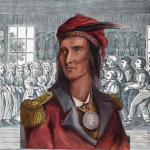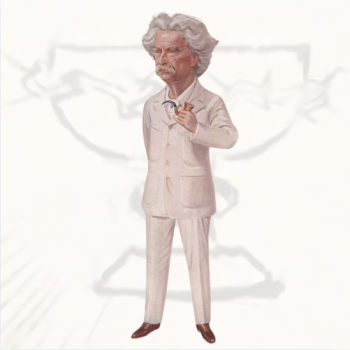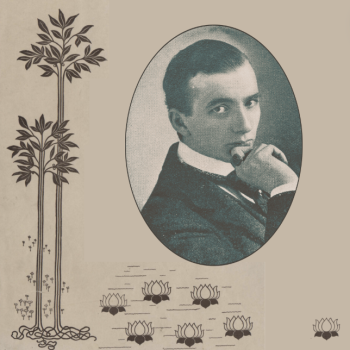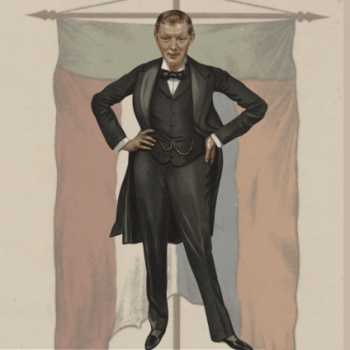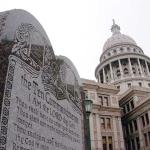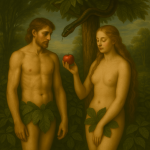In January 1882 Oscar Wilde went to America to produce his first play, “Vera or, The Nihilists,” at New York’s Union Square Theatre, and embarked on a nationwide lecture tour.[1] The country soon embraced the “Aesthetic Fad,” as Wilde was the leading figure of the Aesthetic Movement. (Wilde praised the beauty of the sunflower while touring America, which led to its adoption as an emblem of the movement.)[2]
Wilde, an Irishman, was born in Dublin to Sir William Wilde (a physician, who was widely known in England and on Continent,) and Lady Jane Wilde. His mother, an author who wrote for the Dublin Nation and published several volumes of poems under the pseudonym of “Speranza,” gathered around her a notable company of artists, litterateurs, and politicians. Wilde was a graduate of Magdalen College, Oxford. In 1878 he won the Newdigate Prize for English verse, his subject being “Ravenna.” Wilde then traveled extensively through Europe and published sonnets and translations from Greek tragedies. His love interest at the time was the actress Florence Balcombe who, according to Wilde, was an “exquisitely pretty girl,” possessing the “most perfectly beautiful face” he had ever seen.[3] On December 4, 1878, however, Florence married a young Irish civil servant with literary interests named Bram Stoker at St Anne’s Church, Dublin. In 1878 the actor, Henry Irving, took over London’s Lyceum Theatre and appointed Stoker as the business manager of that enterprise. Irving’s commanding (scornful personality,) simultaneously captivated, and intimidated, those around him. The actor was a slim, towering figure, with long hair (much longer than convention,) a delicate clean-shaven face, and a thin, aquiline nose with queerly arched nostrils. Though he was a mesmerizing virtuoso, he was a demanding employer; he thoroughly depended on the energy of Stoker (who was also his personal assistant) to feed his ravenous ego.[4] “Though you have not thought it worthwhile to let me know of your marriage,” Wilde wrote to Florence, “still I cannot leave Ireland without sending you my wishes that you may be happy.”[5] His feelings for her were strong enough still in 1881 that he asked the actress Ellen Terry to deliver some flowers to Florence backstage at the Lyceum. “I should like to think that she was wearing something of mine the first night she comes on the stage, that anything of mine should touch her,” Wilde writes. “She thinks I never loved her, thinks I forget. My God how could I!”[6]
When Wilde lectured in Boston in 1882, a crowd of sixty Harvard men emulated Wilde’s sense of fashion, wearing “dress coats, knee breeches, and large green neckties,” and it was said, “large clusters of lilies were in their coats, and each carried a sunflower.”[7] (For a time in America both prose and poetry were “full of rose-water.”)[8] Days after visiting Boston, Wilde made a pilgrimage to New Jersey to meet Walt Whitman. They hit it off well. Wilde seemed to Whitman “like a great big, splendid boy.”[9] Whitman was in the process of issuing a new edition of Leaves of Grass, which he was having difficulty publishing due to censorship. It was a book that Wilde’s mother read to him as a child. Though it was not widely circulated, Lady Wilde managed to procure an early copy.[10]
A year later Henry Irving, Stoker, and Ellen Terry made their own tour of America, and Wilde was there to see them off.[11] It was during this trip that Irving and Stoker met Mark Twain. Though not a Theosophist, Twain has a place in the Theosophical mythos as he met Olcott during the summer preamble to the creation of the Theosophical Society. Twain was debuting his play “The Gilded Age,” on the East Coast, while Olcott was preparing to investigate the hauntings on a homestead in Chittenden, Vermont. They were both commissioned to write a piece for the Lotos Club 1875 book, Lotos Leaves. Twain’s contribution, “An Encounter With An Interviewer,” was an interview with himself.[12] Indeed, Twain was fascinated by the concept of “doubles,” “dream selves,” and consciousness, and enjoyed discussing such topics with like-minded individuals.[13] He tried to make people “believe that now and then, by some accident, or otherwise, a dream which was prophetic turned up in the dreamer’s mind.”[14] It was also a topic that Stoker enjoyed discussing. The two men began a lifelong friendship. During this same trip, in March 1884, Irving and Stoker, like Wilde, paid a visit to Whitman.[15]
Back in London, Wilde, along with his mother, and his brother, William, began attending Theosophical soirées. It was here that they were introduced to Mohini Chatterjee. “I never realized before what a mistake we make in being white!” said Wilde upon meeting Mohini.[16] Unimpressed with Wilde’s unsolicited “witticism” at his expense, Mohini would state: “[In English salons] you are presented to one who thinks he is amusing himself by making some stupid remark to you and indulging in talk of no profit to anyone.”[17] In May 1884, Wilde attended Stuart Cumberland’s muscle-reading experiment in the offices of The Pall Mall Gazette with Olcott and Stead.[18] His interactions with the Theosophists during this period would serve as inspiration for Rosa Praed’s novel Affinities. The story is that of a love triangle with a thinly-veiled Oscar Wilde as the “moral vampire” Esme Colquhoun (recently returned from a tour in America.)[19] It was just days before Oscar Wilde’s marriage to Constance Lloyd. Shortly before their marriage, Wilde was interviewed by James Sidney Hargrove, the family solicitor of John Horatio Lloyd (the grandfather of Constance Wilde.) According to Wilde, it was because of his work with the Lloyd family that Hargrove owed much of his own “considerable wealth.”[20] When Hargrove pressed as to his ability to support Constance, Wilde replied: “I could hold out no promise, but I could write you a sonnet if you think that that would be of any help.’”[21] One of James Sidney’s sons, Ernest Temple Hargrove, would succeed W. Q. Judge as President of the American Theosophists and later form the Order of the Living Christ with Charley.[22] Of his impression of Wilde, E.T. Hargrove writes: “Many years ago I met him. I was very young, and what struck me about him chiefly was his bulk and his supercilious manner. Older men who had talked of him in my presence had admitted that he had genius, but they had ridiculed his eccentricity.”[23] After their wedding on May 29, 1884, Oscar and Constance Wilde went to Paris for their honeymoon.[24] While there, they paid a visit to Blavatsky and the Theosophists at the home of Countess Caithness.[25]
Olcott met Robert Browning at this time and “talked some Theosophy with that master of verse.”[26] A literary cultus had developed around Browning in 1881 resulting in the formation of London’s Browning Society. (Stoker and Irving often visited Browning. “Their conversation,” it was said, “no matter how it began, usually swerved round to Shakespeare.”)[27] During the April 1884 meeting of the Browning Society, James Russell Lowell, the American Minister, was the guest chairman.[28] It was an eventful evening. George Bernard Shaw stood up in the face of the whole solemn conclave of the Browning Society and expressed his conviction that Browning was “really one of the least dramatic poets that ever lived.”[29] The “Browning Fad,” also known as “Esoteric Browningism,” found its way to Boston in December 1885.[30] This sentimental literary cultus was formed as an offshoot of the short-lived “Boston Hermetic Society,” by the literary circle of that group.[31] By 1886 other Browning Societies formed around the nation, endeavoring to study the mysterious and hidden meaning behind the words of that ambiguous poet.[32] “One would have thought that Browning wrote his poems in the same way that Ignatius Donnelly says Shakespeare wrote his dramas—in cipher,” it was said. It was during this period (the winter of 1886-1887) that Mark Twain was “studiously, even violently, interested” in the poetry of Browning, and hosted a Wednesday Browning Reading Circle in his Hartford, Connecticut home.[33]
The next big literary sensation was Robert Louis Stevenson’s 1886 novel, Strange Case Of Dr. Jekyll And Mr. Hyde. In this story, Dr. Henry Jekyll develops an elixir that allows him to access his villainous, primal alter-ego, Edward Hyde. While initially able to control the altered self, Dr. Jekyll eventually succumbs to Hyde.[34] In September 1887 Stevenson traveled to New York City where he received interviewers in his rooms at the Victoria Hotel.[35] The timing of the trip coincided with Richard Mansfield’s theatrical production, “Dr. Jekyll And Mr. Hyde,” which debuted on September 12, 1887, at the Madison Square Theatre.[36] During the interviews, Stevenson offered his opinion on American literature. “With regard to American authors, I have been especially delighted with the new start made by Henry James,” Stevenson said. “He seems one of the very few who are feeling around for new effects.” The brother of Harvard’s first psychologist, it was said: “William James was a psychologist who wrote like a novelist and Henry James a novelist who wrote like a psychologist.”[37] When asked what inspired him to write “Jekyll and Hyde,” Stevenson said: “I dreamed the story […] It came to me as a gift.”[38] Twain met Stevenson in New York during this visit, speaking with him for over an hour on a bench in Washington Square.[39] Interested in what may be called “frontier science,” Twain, like William James, joined the Society for Psychical Research in 1884, and was one of the first contributors to their journal.[40]
The Lyceum made another tour of America in 1887. In November 1887 Stoker invited Twain to a performance of “Faust” at The Star Theatre in New York.[41] (It is unknown if Twain was able to attend, however.) Later that week, Stoker delivered a lecture at Chickering Hall, “Abraham Lincoln,” based on Whitman’s notes. The audience was small. Major James Burton Pond, the renowned lecture manager who was responsible for the talk, stated that “nobody cares to listen to a lecture on Abraham Lincoln in this country.”[42] Stoker met Whitman again a month later, and the men discussed the censorship of Leaves Of Grass.[43] During the tour, Henry Irving saw a performance of Mansfield’s “Dr. Jekyll and Mr. Hyde.” Impressed with Mansfield’s performance, Irving invited him to perform the show at the Lyceum in London, to which Mansfield accepted.[44]
One of the interviews with Stevenson in The New York Herald was reprinted in The Pall Mall Gazette and found its way to Blavatsky. She offered her comments in an article “The Signs Of The Times,” in the second issue of Lucifer. “Literature—especially in countries free from government censorship—is the public heart and pulse,” wrote Blavatsky. “Besides the glaring fact that were there no demand there would be no supply, current literature is produced only to please, and is therefore evidently the mirror which faithfully reflects the state of the public mind.”[45] In her opinion, there was no grander psychological essay on occult lines existed than Dr. Jekyll and Mr. Hyde.”[46] For her it was an allegory for the extremities of the spectrum of the human soul, from our “animal” part to our “Higher Self.”[47] This was known as the septenary (“seven-fold” conception of personhood. Something like a Russian nesting-doll, that is, a single “doll” comprised in layers. The smallest four dolls being the soul’s lower “animalistic” parts, or the “Hyde.” The largest three “dolls” would be the trinitarian aspect of our “High Selves,” or our “Christos.”[48]
The world of popular fiction was where Theosophical teachings truly gained a footing. “There is growing every day among contemporary writers a strong disposition to take up theosophic doctrine,” Judge stated. “This will grow as time goes on, for everyone with any means of judging knows that the doctrines of Karma and Reincarnation are gaining a hold, slowly perhaps, but surely, on the public mind. Both of these offer a wide field for novelists and magazine writers.”[49] Laura C. Holloway echoed the sentiments of Blavatsky and Judge regarding the Theosophical influence on popular media in an article for the Brooklyn Times-Union: “The most careless of observers must have noticed in the past four years the growing tendency in modern literature to discuss mysticism, occultism, and theosophy.”[50] She listed for examples: Marion Crawford’s Mr. Isaacs, Rider Haggard’s King Solomon’s Mines, and She, and Marie Corelli’s The Romance Of Two Worlds (which introduced the concept of “Twin Flames.”)[51] Other corners of the secular press took note as well. “There is little doubt that the influence of Blavatsky […] is making itself far more widely felt than many people imagine,” one British paper remarked. Popular literature was “doing more to arouse public interest than any purely technical book on the subject is capable of accomplishing.”[52] In California, one San Francisco paper stated: “The bookstores are full of feeble-witted volumes on Theosophy, telepathy, reincarnation, and esoteric Buddhism. Even the fashionable novelists have caught the fever.”[53]
In the late summer of 1888, there were two productions of Jekyll & Hyde happening in London. In addition to Mansfield’s “Dr. Jekyll and Mr. Hyde” at the Lyceum there was a production by rival actor, Daniel Bandmann, who decided to stage his own production on August 6, 1888, at the Opéra Comique. This prompted Mansfield to move the opening night of his production to August 4, 1888.[54]
Following Mansfield’s production, the Lyceum staged “Macbeth.” On opening night, a stream of carriages rolled up through the murky December fog. The Strand, alive with the roars of “Murder!” “Murder!” from the Ripper scare, attuned the minds of those who had seats in the Lyceum to Shakespeare’s famous murder case. The line of carriages extended far away down the busy thoroughfare, and a curious crowd blocked the entrance to the theater, peering with anxiety into every brougham, and gazing with curiosity at anyone who forged their way past the frowning columns that formed the approach to the Lyceum. The soft, red lamps which burned in the handsome foyer, cast a religious light upon the eager mob who jostled each other in disregard of all canons of politeness. Stoker added fuel to the fire by the stage with an uncanny look in his eyes as he “did the civil” in an anxious sort of way to the throng who struggled up the broad staircase. At least twenty minutes before the curtain went up the auditorium was packed and only a few vacant lots were to be seen in the stalls.[55] Oscar Wilde was among them.
It was December 29, 1888, just days after Wilde had Christmas dinner with Yeats.[56] Earlier that day Wilde was among the representative people from the worlds of art, literature, and society who crowded together in the New Galleries to pay their devotions to the various relics of the Royal House of Stuart enshrined in the New Galleries. It was an event sponsored by the Jacobite Society and the Order of the White Rose.[57] “Of course, the Lyceum Theater was unrepresented in the crowd of the afternoon,” it was said, owing to the opening of Macbeth. The nearest “touch” with it was obtained by the presence of several members of the Terry family, and Florence Stoker, the wife of Bram Stoker. She was the daughter of Army Lieutenant-Colonel James Balcombe and his wife, Phillipa Anne. Wilde, who briefly courted Florence in their youth, described her as an “exquisitely pretty girl,” possessing the “most perfectly beautiful face” he ever saw. Like Wilde, Florence was a consummate snob who enjoyed the reflected celebrity of her former suitor’s growing cult.[58]
Another notable man who was present was John Aird, a distinguished engineer whose projects included the Crystal Palace, and the Royal Albert Hall.[59] (In December 1888 Aird was proposing another International Exhibition at the Crystal Palace.)[60] In 1888 Aird commissioned the painting, “The Roses of Heliogabalus,” from Alma Tadema (a frequenter of Blavatsky’s “At Homes.”)[61] Wilde knew of him (if only peripherally,) for Aird’s sister (Jessie Aird) was the wife of James Sidney Hargrove.[62] Aird was an M.P. of Paddington North and it was said that he “took his [political cues] from his friend and political godfather, Lord Randolph Churchill,” the M.P. of Paddington South; a family friend, neighbor, and father of Winston Churchill.[63] In addition to Aird’s feats of civil engineering, he was also a patron of the arts and Master Mason—being the first Master of London’s Evening Star Lodge.[64] Two years earlier, Aird indirectly solved the mystery of the previous infamous murders in Whitechapel. When the “Airdsmen” excavated a trench for the Commercial Gas Company, they discovered a skeleton with a stake driven through it and chains lying near the bones.[65] Perhaps an element of this found its way into Stoker’s 1897 novel, Dracula. Aird certainly knew Stoker and Irving (his Masonic brothers,) and was present with both men at the unveiling of the Sarah Siddons statue just days after Dracula hit the shelves.[66] Aird also may have had an indirect hand in the popularization of the mummy in horror. In the 1890s Aird was contracted to build the first Aswan Dam and in 1901 he became “the first man ever to cross the Nile dry-footed.”[67] During the construction, Aird discovered an (alleged) six-thousand-year-old necklace; a necklace whose former owner appeared to Marie Corelli as an apparition.[68] (Aird returned to Egypt in 1902 for the opening ceremony of the dam with Tadema and Winston Churchill.)[69]
Whatever tributaries of inspiration that flowed into Dracula, what is known is that vampirism was a topic that was discussed among Theosophists at the time. In 1889 Franz Hartmann even wrote an essay for Lucifer titled “A Modern Case Of Vampirism.”[70] (Incidentally, it was a topic that Hartmann revisited with Roslyn D’Onston in 1896 in W.T. Stead’s Borderland.)[71] Stoker began working on the novel while vacationing in Whitby, England, in March 1890. The idea, Stoker said, came to him in a dream.[72] A direct link between Stoker and the Theosophists can be found in the person of Lady Emily Thornley Stoker (Stoker’s sister-in-law,) who joined the Dublin Lodge of the Theosophical Society in February 1892.[73] Dracula was not the only story that developed in this atmosphere. The Ripper murders created a public demand for dark crime stories. Both Wilde and Arthur Conan Doyle were commissioned to write pieces for Lippincott’s Monthly Magazine. Wilde’s contribution was “The Picture Of Dorian Gray,” and Doyle’s was another Sherlock Holmes story, “The Sign Of Four.”[74]
In the Autumn of 1891, W.T. Stead (whose death would also contribute to the mummy mythos) wrote encouragingly about the Theosophists in a recent issue of The Review Of Reviews, as well as his friend, Annie Besant.[75] The special Christmas issue of that magazine for 1891, Real Ghost Stories, hit the newsstands in the middle of November. All three hundred thousand issues sold out within two days.[76] It dealt with, among other subjects, the “fascinating question popularized by [Robert] Louis Stevenson in his well-known story of ‘Dr. Jekyll and Mr. Hyde,’ namely, that of multiple personality.”[77] (Stead himself would begin his serious exploration into paranormal phenomena at this time, finding he had a skill for automatic-writing.)[78] In December 1891, Mark Twain wrote a piece for Harper’s New Monthly Magazine titled “Mental Telegraphy.” In the essay, Twain stated: “I am forced to believe that one human mind (still inhabiting the flesh) can communicate with another, over any sort of a distance, and without any artificial preparation of ‘sympathetic conditions’’ to act as a transmitting agent.”[79] Though Twain attempted to articulate his theory of “Mental Telegraphy,” he had to censor the meatier parts of his idea.[80] It was not for want of intellectual vigor. When he met William James a year later, the eminent psychologist tried convincing Twain to move to Cambridge.[81] As for James, he, too, would publish an influential work at this time, Psychology: Briefer Course, in which he tackles the concepts of soul, spirit, ego, and consciousness. It was his work at the time which gave us the expression “stream of consciousness.”[82] Twain discussed these themes with Stoker in December 1893 when he was among the guests who attended the Lotus Club dinner for Henry Irving.[83] Strolling up and down Fifth Avenue, the men exchanged views in the conflict of duality, on nightmares, and on the unconscious. “Every man is a moon and has a dark side which he never shows to anybody.” Twain at the time was involved in an ill-fated typesetter scheme, which Stoker invested in.[84]
Weeks later Twain met Nikola Tesla at a gathering with the artist Robert Reid. Jokes and stories were swapped, and songs were sung, particularly Kipling’s “On the Road to Mandalay.” On March 4, 1894, Twain called on Nicola Tesla in his New York laboratory, to experience first-hand the new inventor’s new mechanism.[85] Two days after that (March 6,) Twain departed for Europe on board the City of New York.[86] It was during this trip that Twain met W.T. Stead, whose just released the third issue of Borderland. With this new enterprise, Stead endeavored to popularize Psychical Research by publishing articles in that field which married the optimistic enthusiasm of religious sentiment with the scrutiny of empirical science.[87] Through the course of their discussions, the men realized that they shared an interest in the metaphysical.[88]
Wilde, meanwhile, was in the midst of a highly publicized trial. After the publication of The Picture Of Dorian Gray, Wilde was introduced to Lord Alfred Douglas, an undergraduate from Oxford. A homosexual relationship developed. Douglas’s father, the Marquess of Queensbury, subsequently set a trap for Wilde, leaving a calling card for the author which stated: “For Oscar Wilde, posing as a sodomite.” Wilde took Queensbury to trial for defamatory libel. Queensbury was arrested but could avoid conviction by demonstrating that the statement was true. The statement was true. Wilde’s imprisonment had caused him bankruptcy.[89] His fall from grace was almost total. James Sydney received a prison-letter from Wilde around this time that was meant to be forwarded to Constance. The Lloyd family solicitor was pleasantly surprised to discover that Wilde’s letter was both sentimental and sincere. “One of the most touching […] letters that had ever come under my eye,” James Sydney said.[90]
In America, Twain was also facing financial difficulties. The typesetter scheme failed, and he nearly lost everything. To begin paying his creditors, Twain contracted Major Pond to help manage a publicity tour. Twain left his summer home near Elmira, New York, in July 1895, to lecture across North America for five weeks, followed by a world tour.[91] In Tacoma, he spoke with a reporter about the palmistry experiment in Borderland.[92] (Perhaps the subject was on his mind, as he published a follow-up to “Mental Telegraphy” for the September issue of Harper’s Monthly Magazine.) [93] It was in this capacity that Twain found himself in India at the Watson’s Hotel.[94] While in India, Twain asked Olcott to visit him in India to cheer him up when he was sick.[95] The two men reminisced over “old incidents of [their] association in the famous Lotos Club, New York, and [their] meetings at Boston, Hartford, Washington, and elsewhere.”[96] Twain concluded his tour when he reached England at the end of July 1896, settling in Guilford with his wife Livy, and daughter, Clara. In the middle of August 1896, Twain’s other daughter, Susy, died unexpectedly in the family home in Hartford, Connecticut. The crushing news delayed Twain’s work and darkened his attitude. Twain went into seclusion after the death of Susy in 1896. In October 1896, Twain and his family moved to a rented house at 23 Tedworth Square in Chelsea and finally started writing during the last week of October. Twain said he wrote the book “in hell,” trying to give the impression that “it was an excursion through heaven.” To lighten the manuscript’s tone, he deleted many passages containing self-pitying remarks.[97] He was embittered, as a letter to Bram Stoker at the time indicates. Twain complained of a surly ticketing agent at the Lyceum and demanded that he be fired.[98] Even many of Twain’s closest friends in England were not aware that he was living in London. It just so happened that the flat Twain and his family lived in, was near the home of Bram and Florence Stoker (St. Leonard’s Terrance, London.) Stoker was one of the few people Twain would see with any regularity during his mourning.[99] Among other things Twain would include in Following The Equator was the line: “Faith is believing what you know ain’t so.”[100] It was a statement along similar lines as to what William James had said in “The Will To Believe.”[101] Perhaps it was either Twain or James who Stoker was thinking of while completing the final draft of Dracula, as Van Helsing cites a certain American whose definition of faith is resonant with both those Americans. Van Helsing states:
My thesis is this: I want you to believe […] in things that you cannot. Let me illustrate. I heard once of an American who so defined faith: “that faculty which enables us to believe things which we know to be untrue.” For one, I follow that man. He meant that we shall have an open mind, and not let a little bit of truth check the rush of a big truth, like a small rock does a railway truck. We get the small truth first. Good! We keep him, and we value him; but all the same we must not let him think himself all the truth in the universe.[102]
A week before Dracula was published Wilde was released from jail. He had gone through something of a transformation. As the Pall Mall Gazette stated on May 19, “during the latter part of his hard labour, [Wilde] has been mainly occupied with the repairing and re-binding of the prison hymn books, books of Common Prayer, and Bibles.”[103]
SOURCES:
[1] Kohl, Norbert. Oscar Wilde: The Works Of A Conformist Rebel. Cambridge University Press. Cambridge, England. (2011): 35.
[2] Nelson, E. Charles. “Helianthus Annuus ‘Oscar Wilde’: Some Notes on Oscar and the Cult[ivation] of Sunflowers.” The Wildean. No. 43. (July 2013): 2-25.
[3] Skal, David J. Something In The Blood: The Untold Story Of Bram Stoker, The Man Who Wrote Dracula. W. W. Norton & Company. (2016): Chapter Four; Belford, Barbara. Bram Stoker: A Biography Of The Author Of Dracula. Phoenix Giant. London, England. (1997): 127.
[4] “Sir Henry Irving In America.” The Theatre: A Monthly Review And Magazine. Vol. XXVII, No. 162 (June 1896): 361-65; Stoker, Bram. Personal Reminiscences Of Henry Irving: Volume 2. The MacMillan Company. New York, New York. (1906): 260-261; Richards, Jeffrey. Sir Henry Irving: A Victorian Actor And His World. A&C Black. London, England. (2007): 109; Kilgarriff, Michael. “The Knight From Nowhere’ Sir Henry Irving 1838-1905.” The Irving Society. [Accessed February 26, 2019.]
[5] Wilde, Oscar; (ed.) Rupert, Hart-Davis. The Letters Of Oscar Wilde. MacMillan And Company Limited. Bombay, India. (1967): 54. [Oscar Wilde to Florence Balcombe. Late 1878.]
[6] Wilde, Oscar; (ed.) Rupert, Hart-Davis. The Letters Of Oscar Wilde. MacMillan And Company Limited. Bombay, India. (1967): 74. [Oscar Wilde to Ellen Terry. January 3, 1881.]
[7] “Current Events.” The Brooklyn Daily Eagle. (Brooklyn, New York) February 1, 1882.
[8] Vance, L.J. “Literary ‘Fads.’ The Epoch. Vol. IV, No. 83 (September 7, 1888) 80.
[9] “Walt And Sweet Oscar.” The Nashville Banner. (Nashville, Tennessee) January 26, 1882.
[10] Mendelssohn, Michèle. Making Oscar Wilde. Oxford University Press. Oxford, England. (2018): 127.
[11] Terry, Ellen. The Story Of My Life: Recollections And Reflections. Doubleday, Page & Co. New York, New York. (1908): 275.
[12] Brougham, John; Elderkin, John (eds.) Lotos Leaves: Original Stories, Essays, And Poems By The Great Writers Of America And England. William F. Gill And Company. Boston, Massachusetts. (1875): 25-33.
[13] Horn, Jason Gary. Mark Twain And William James: Crafting A Free Self. University Of Missouri Press. Columbia, Missouri. (1996): 136.
[14] Twain, Mark. Mark Twain’s Autobiography: Vol. I. Harper & Brothers Publishers. New York, New York. (1924): 306.
[15] Stoker, Bram. Personal Reminiscences Of Henry Irving: Vol. II. The MacMillan Company. New York, New York. (1906): 92; Belford, Barbara. Bram Stoker: A Biography Of The Author Of Dracula. Phoenix Giant. London, England. (1997): 166-167, 282.
[16] Leadbeater, Charles Webster. How Theosophy Came To Me. Theosophical Publishing House. London, England. (1930): 23-24.
[17] “Babu Mohini Mohun Chatterji.” Fall River Daily Evening News. (Fall River, Massachusetts) November 29, 1886.
[18] “Muscle Reading By Mr. Stuart Cumberland.” The Pall Mall Gazette (London, England) May 24, 1884; Dibb, Geoff. “Oscar Wilde and The Mystics. Thought Transference, The Detection Of Crime And Finding A Pin.” The Wildean No. 42 (January 2013): 82-99.
[19] Campbell-Praed, Rosa. Affinities. George Routledge And Sons. London, England. (1886); McCann, Andrew. “Rosa Praed And The Vampire-Aesthete.” Victorian Literature And Culture. Vol. XXXV, No. 1 (2007): 175–87.
[20] Oscar Wilde to More Adey. April 7, 1897. In The Letters of Oscar Wilde. London, UK: Rupert Hart-Davis, 1962. 524-28.
[21] Otho Lloyd to Mr. Symonds. [MS. WILDE BX 32 FLD 20 Lloyd 1937 May 27]
[22] Ernest Temple Hargrove was born on December 17, 1870, at Laurel Lodge, Twickenham, in West London, to James Sydney Hargrove and Jessie (née Aird) Hargrove. He would have been the couple’s fifth child, however, two weeks before Ernest was born, on December 3, 1870, his 18-month-old-sister, also named Jessie, died in the family home. Ernest would be the fourth oldest of eight Hargrove children; ranking from oldest to youngest, they were: Constance, Norah, Sidney, Ernest, Percy, Herbert, Reginald, and Hilda. By all accounts, the family were close, and the home life was happy, with a “refined English atmosphere.” [“Deaths.” The London Daily News (London, England) December 6, 1870. [“Births, Marriages, and Deaths.” London Observer, December 25, 1870. England & Wales, Civil Registration Birth Index, 1837-1915. Registration Year: 1871. Registration Quarter: Jan-Feb-March. Registration District: Brentford. Volume 3A. Page: 63. [database on-line]. Provo, UT, USA.] 1881 England Census. Class: RG11; Piece: 656; Folio: 104; Page: 17; GSU roll: 1341152.]
Kate Swan, “Preaching Theosophy to Socialists,” The New York World (New York, New York) May 10, 1896.
[23] H. “Reviews: De Profundis, or the Breaking and Making of a Man.” Theosophical Quarterly. Vol. III, No. 2. (October 1905): 332-225.
[24] Page, Norman. An Oscar Wilde Chronology. Springer. New York, New York. (1991): 28.
[25] V. P. Zhelihovskaya. “Letters From Abroad (Fragment.)” [Bakhmut Roerich Society.]
[26] Olcott, Henry Steel. Old Diary Leaves: Volume III. Theosophical Publishing Society. London, England. (1904): 98.
[27] Stoker, Bram. Personal Reminiscences Of Henry Irving: Vol. II. The MacMillan Company. New York, New York. (1906): 89.
[28] “The Monthly Abstract Of What Was Done At The Society’s Meetings. The Browning Society’s Papers, 1881-1884: Part V. (April 25, 1884): 112-124.
[29] “Occasional Notes.” The Edinburgh Evening News. (Edinburgh, Scotland) May 5, 1884.
[30] Lang, Andrew. “Esoteric Browningism.” The Forum. Vol. VI, No. 3. (November 1888): 300-310.
[31] Boston Browning Society. The Boston Browning Society Centenary Yearbook. Boston Browning Society. Boston Massachusetts. (1912):17-25.
[32] B.F.U. “Current Topics.” The Index. Vol. VI, No. 31. (January 28, 1886): 361.
[33] Paine, Albert Bigelow. Mark Twain: A Biography. Vol. III. Gabriel Wells. New York, New York. (1912): 846.
[34] Jekyll states his motives for the experiment: “With every day, and from both sides of my intelligence, the moral and the intellectual, I thus drew steadily nearer to that truth, by whose partial discovery I have been doomed to such a dreadful shipwreck: that man is not truly one, but truly two […] I, for my part, from the nature of my life, advanced infallibly in one direction and in one direction only. It was on the moral side, and in my own person, that I learned to recognize the thorough and primitive duality of man; I saw that, of the two natures that contended in the field of my consciousness, even if I could rightly be said to be either, it was only because I was radically both […] If each, I told myself, could be housed in separate identities, life would be relieved of all that was unbearable; the unjust might go his way, delivered from the aspirations and remorse of his more upright twin; and the just could walk steadfastly and securely on his upward path, doing the good things in which he found his pleasure, and no longer exposed to disgrace and penitence by the hands of this extraneous evil. It was the curse of mankind that these incongruous faggots were thus bound together—that in the agonized womb of consciousness, these polar twins should be continuously struggling. How, then were they dissociated?” [Stevenson, Robert Louis. Strange Case Of Dr. Jekyll And Mr. Hyde. Charles Scribner’s Sons. New York, New York. (1886): 106-107.]
[35] “Robert L. Stevenson In Town.” The Sun. (New York, New York) September 8, 1887.
[36] “Notes Of The Week.” The New York Times. (New York, New York) September 11, 1887.
[37] Olney, James. “Psychology, Memory, And Autobiography: William And Henry James.” The Henry James Review. Vol. VI, No. 1 (Fall 1984): 46-51.
[38] Stevenson said: “For instance, all I dreamed about Dr. Jekyll was that one man was being pressed into a cabinet, when he swallowed a drug and changed into another being. I awoke and said at one that I had found the missing link for which I had been looking so long, and before I again went to sleep almost every detail of the story, as it stands, was clear to me.” [“Mr. Robert Louis Stevenson In America.” The Pall Mall Gazette. (London, England) September 22, 1887.]
[39] Twain, Mark. “Chapters from My Autobiography: II.” The North American Review. Vol. 183, No. 599 (Sep. 21, 1906): 449-460.
[40] “Hartford, Connecticut, October 4th, 1884. Dear Sir,—I should be very glad indeed to be made a Member of the Society for Psychical Research; for Thought-transference, as you call it, or mental telegraphy as I have been in the habit of calling it, has been a very strong interest with me for the past nine or ten years. I have grown so accustomed to considering that all my powerful impulses come to me from somebody else, that I often feel like a mere amanuensis when I sit down to write a letter under the coercion of a strong impulse: I consider that that other person is supplying the thoughts to me, and that I am merely writing from dictation. And I consider that when that other person does not supply me with the thoughts, he has supplied me with the impulse, anyway: I never seem to have any impulses of my own. Still, maybe I get even by unconsciously furnishing other people with impulses.” [Twain, Mark. “Mark Twain On Thought-Transference.” The Journal Of The Society For Psychical Research. Vol. I, No. 9 (October 1884): 166-167.]
[41] Henry W. and Albert A. Berg Collection of English and American Literature, The New York Public Library. “Stoker, [Bram], AL. [Nov. 19, 1887]. Previously [n.d.].” New York Public Library Digital Collections. Accessed November 16, 2024.
[42] “Bram Stoker’s Lecture.” The New York Times. (New York, New York) November 26, 1887; “Major J. B. Pond is Dead.” The New York Times. (New York, New York) June 22, 1903.
[43] Belford, Barbara. Bram Stoker: A Biography Of The Author Of Dracula. Phoenix Giant. London, England. (1997): 197-198.
[44] Danahay, Martin A., and Alexander Chisholm, eds. Jekyll And Hyde Dramatized: The 1887 Richard Mansfield Script And The Evolution Of The Story On Stage. McFarland & Company. Jefferson, North Carolina (2005):15-16, 55-57, 77-78.
[45] Blavatsky writes: “It is curious to note that Mr. Stevenson, one of the most powerful of our imaginative writers, stated that he is in the habit of constructing the plots of his tales in dreams.” [Blavatsky, Helena P. “The Signs Of The Times.” Lucifer. Vol. I, No. 2 (October 15, 1887): 83-89.]
[46] Blavatsky, Helena P. The Secret Doctrine Vol. II: Anthropogenesis. The Theosophical Publishing Company. London, England. (1888): 317;
[47] Blavatsky states: “The future of the Lower Manas is more terrible, and still more terrible to humanity than to the now animal man. It sometimes happens that after the separation the exhausted Soul, now become supremely animal, fades out in Kâma-Loka, as do all other animal souls. But seeing that the more material the human mind, the longer it lasts, in that intermediate stage, it frequently happens that after the actual life of the soulless man is ended, he is again and again reincarnated into new personalities, each one more abject than the other. The impulse of animal life is too strong; it cannot wear itself out in one or two lives only. In rarer cases, however, something far more dreadful may happen. When the lower Manas is doomed to exhaust itself by starvation; when there is no longer hope that even a remnant of a lower light will, owing to favorable conditions––say, even a short period of spiritual aspiration and repentance––attract back to itself its Parent Ego, then Karma leads the Higher Ego back to new incarnations. In this case the Kâma-Mânasic spook may become that which we call in Occultism the ‘Dweller on the Threshold.’ This ‘Dweller’ is not like that which is described so graphically in Zanoni, but an actual fact in nature and not a fiction in romance, however beautiful the latter may be. Bulwer must have got the idea from some Eastern Initiate. Our ‘Dweller,’ led by affinity and attraction, forces itself into the astral current, and through the Auric Envelope of the new tabernacle inhabited by the Parent Ego, and declares war to the lower light which has replaced it. This, of course, can only happen in the case of the moral weakness of the personality so obsessed. No one strong in his virtue, and righteous in his walk of life, can risk or dread any such thing; but only those depraved in heart. Robert Louis Stevenson had a glimpse of a true vision indeed when he wrote his Strange Case of Dr. Jekyll and Mr. Hyde. His story is a true allegory. Every Chela would recognize in it a substratum of truth, and in Mr. Hyde a ‘Dweller,’ an obsessor of the personality, the tabernacle of the ‘Parent Spirit.’” [Blavatsky, Helena P. Collected Writings Volume XII (1889-1890.) Theosophical Publishing House. Wheaton, Illinois. (1980): 636-638. [E.S. Instruction No. III.]]
[48] Blavatsky, Helena Petrovna. The Key To Theosophy. Theosophical Publishing Company. New York, New York. (1896): 63-64; Ludlow, William. “Theosophy.” The Detroit Free Press. (Detroit, Michigan) January 24, 1892; Cavé. “Questions and Answers.” The Theosophical Forum. Vol. IV, No. 2 (June 1898): 1-4; “Fifty Years.” The Theosophical Quarterly. Vol. XXIII. No. 3. (January 1926.) 209-211.
[49] Judge, William Quan. “Contemporary Literature and Theosophy.” The Path. Vol. III, No. 3 (June 1888): 92-94.
[50] Holloway writes: “.” [Holloway, Laura C. “Theosophy In Literature.” The Times Union. (Brooklyn, New York.) March 16, 1889.]
[51] “There are people, however, who do care, and who never find their Twin-Flame or companion Spirit at all on earth, and never will find it […] No doubt you think I am talking very wildly about Twin-Flames and Spiritual Affinities that live for us in another sphere. You do not believe, perhaps, in the existence of beings in the very air that surrounds us invisible to ordinary human eyes, yet actually akin to us, with a closer relationship than any tie of blood known on earth?” [Corelli, Marie. A Romance Of Two Worlds. George M. Hill. Chicago, Illinois. (1898): 171.]
[52] “The Mystery of Cloomber.” The Portsmouth Evening News. (Hampshire, England) January 3, 1889.
[53] “Trite Theosophy.” The San Francisco Examiner. (San Francisco, California) October 14, 1888.
[54] [Danahay, Martin A., and Alexander Chisholm, eds. Jekyll And Hyde Dramatized: The 1887 Richard Mansfield Script And The Evolution Of The Story On Stage. McFarland & Company. Jefferson, North Carolina (2005):15-16, 55-57, 77-78; “Lyceum Theatre” The Daily Telegraph. (London, England) August 6, 1888; “The Nightmare At The Lyceum” Pall Mall Gazette. (London, England) August 7, 1888; “Last Night’s Theatricals” Loyd’s Weekly Newspaper. (London, England) August 5, 1888; “Lyceum Theatre” The Daily Telegraph. (London, England) August 6, 1888.]
[55] “Macbeth At The Lyceum.” The Pall Mall Gazette. (London, England) December 31, 1888; “The First Night Of ‘Macbeth.’” The Daily News. (London, England) December 31, 1888.
[56] Yeats, William Butler. Four Years. The Cuala Press. Dublin, Ireland. (1921): 21-22; Yeats, William Butler; Donoghue, Denis (ed.) Memoirs. Macmillan, London, England (1972): 21-23; Jeffares, A. Norman. W.B. Yeats: A New Biography. Continuum. London, England. (2001): 33.
[57] “The Private View Of The New Gallery.” The Daily News. (London, England) December 31, 1888; “Representative People From…” St. Stephen’s Review. Vol. I, No. 304. (January 5, 1889): 8; Guthrie, Neil. The Material Culture Of The Jacobites. Cambridge University Press. Cambridge, England. (2013): 155.
[58] Skal, David J. Something In The Blood: The Untold Story Of Bram Stoker, The Man Who Wrote Dracula. W. W. Norton & Company. (2016): Chapter Four; Belford, Barbara. Bram Stoker: A Biography Of The Author Of Dracula. Phoenix Giant. London, England. (1997): 127.
[59] “Sir John Aird, Bart., M.P.” The Strand. Vol. XXX, No. 178 (November 1905): 453-455.
[60] Aird, John. “An International Exhibition At The Crystal Palace.” The Daily News. (London, England) December 31, 1888.
[61] “Pictures And Their Purchasers.” The Pall Mall Gazette. (London, England) May 2, 1888; Russell writes: “Felix Moscheles, Robert Browning, Whistler, and Alma Tadema were among those of my own especial friends whom I have seen at Madame Blavatsky’s [home.]” [Russell, Edmund. “Mme. Blavatsky.” The St. Louis Post-Dispatch. (St. Louis, Missouri) May 13, 1891.]
[62] Aird, Charles. Deptford, Toronto and Kingston: The Early Years of Charles Aird, Victorian Engineer. The Grimsay Press. Glasgow, Scotland. (2005): 332-333.
[63] “Great Engineer Was Sir J. Aird.” The Province. (Vancouver, British Columbia), February 11, 1911.
[64] Boyles, J.F. “The Private Art Collections of London.” The Art Journal Vol. 53 (1891):135-140.
“The Evening Star Lodge, No. 1719” The Freemason’s Chronicle. Vol. XIII, No. 327. (April 2, 1881): 229.
“Quarterly Communications Of The United Grand Lodge” The Freemason’s Chronicle. Vol. XXXIII, No. 843. (March 7, 1891): 152-155.
[65] “Discovery Of A Staked Skeleton.” The North-Eastern Daily Gazette. (Middlesbrough, England) July 31, 1886; Chronicles Of Crime And Criminals. Beaver Publishing Company. Toronto, Canada. (1895): 40-45; Lowman, Emma Battell; Tarlow, Sarah. Harnessing the Power of the Criminal Corpse. Springer. Cham, Switzerland. (2018): 101.]
[66] “The Siddons Statue.” The Era. (London, England) June 19, 1897.
[67] “Assouan As A Tourist Resort.” The Guardian. (London, England) February 21, 1901; “The Dam Across The Nile.” The New York Times. (New York, New York) February 10, 1901; “Court Circular.” The Times. (London, England) February 18, 1901; “Utility And Beauty Ever Fighting.” The Christian Advocate. Vol. LXXVI, No. 9 (February 28, 1901): 324.
[68] Vyer, Bertha. Memoirs Of Marie Corelli. Alston Rivers Ltd. London, England. (1930): 186.
[69] “Our London Correspondence.” The Guardian. (London, England) November 19, 1902; “The Nile Barrage.” The Guardian. (London, England) December 10, 1902.
[70] Hartmann, Franz. “A Modern Case Of Vampirism.” Lucifer. Vol. IV, No. 21 (May 15, 1889): 241-242.
[71] Hartmann, Franz. “Vampires.” Borderland. Vol. III, No. 3 (July 1896): 353-356.
[72] Ludham, Harry. A Biography Of Dracula: The Life Story Of Bram Stoker. W. Foulsham & Company. London, England. (1962): 106-107; Belford, Barbara. Bram Stoker: A Biography Of The Author Of Dracula. Phoenix Giant. London, England. (1997): 220-221.
[73] Theosophical Society General Membership Register, 1875-1942 at http://tsmembers.org/. See book 1, entry 9968. (website file: 1C:1890-1894) Lady Emily Thornley Stoker. Joined 2/18/92.
[74] Flanders, Judith. The Invention Of Murder: How The Victorians Revelled In Death And Detection. MacMillan. New York, New York. (2013): 454-455.
[75] “The Census Of Ghosts.” The Review Of Reviews. Vol. IV, No. 21 (October 1891): 347; “Character Sketch: Mrs. Annie Besant.” The Review Of Reviews. Vol. IV, No. 21 (October 1891): 349-368.
[76] “‘Real Ghost Stories,’ And Its Sequel, ‘More Ghost Stories.’” The Review Of Reviews. Vol. IV, No. 23 (November 1891): 574; Haweis, H. R. “Ghosts And Their Photographs.” Our Day. Vol. XI, No. 63 (March 1893): 182-194.
[77] “The Census Of Ghosts.” The Review Of Reviews. Vol. IV, No. 21 (October 1891): 347.
[78] Stead, William Thomas. After Death, Or, Letter From Julia. The Progressive Thinker Publishing House. Chicago, Illinois. (1910): 5-9.
[79] Twain writes: “I have never seen any mesmeric or clairvoyant performances or spiritual manifestations which were in the least degree convincing—a fact which is not of consequence, since my opportunities have been meager; but I am forced to believe that one human mind (still inhabiting the flesh) can communicate with another, over any sort of a distance, and without any artificial preparation of “sympathetic conditions” to act as a transmitting agent. I suppose that when the sympathetic conditions happen to exist the two minds communicate with each other, and that otherwise they don’t; and I suppose that if the sympathetic conditions could be kept up right along, the two minds would continue to correspond without limit as to time.” [Twain, Mark. “Mental Telegraphy: A Manuscript With A History.” Harper’s New Monthly Magazine. Vol. LXXXIV No. 390. (December 1891): 95-104.]
[80] Twain writes: “I have never seen any mesmeric or clairvoyant performances or spiritual manifestations which were in the least degree convincing—a fact which is not of consequence, since my opportunities have been meager; but I am forced to believe that one human mind (still inhabiting the flesh) can communicate with another, over any sort of a distance, and without any artificial preparation of “sympathetic conditions” to act as a transmitting agent. I suppose that when the sympathetic conditions happen to exist the two minds communicate with each other, and that otherwise they don’t; and I suppose that if the sympathetic conditions could be kept up right along, the two minds would continue to correspond without limit as to time.” [Twain, Mark. “Mental Telegraphy: A Manuscript With A History.” Harper’s New Monthly Magazine. Vol. LXXXIV No. 390. (December 1891): 95-104.]
[81] James, William. The Letters of William James: Vol. I. The Atlantic Monthly Press. Boston, Massachusetts. (1920): 331-335.
[82] James, William. Psychology: Briefer Course. Henry Holt & Company. New York, New York (1892): 200, 215.
[83] “Table Gossip.” The. Boston Globe. (Boston, Massachusetts) December 17, 1893.
[84] Twain, Mark. Mark Twain’s Correspondence With Henry Huttleston Rogers, 1893-1909. University of California Press. Berkeley, California. (1969): 40-41; Belford, Barbara. Bram Stoker: A Biography Of The Author Of Dracula. Phoenix Giant. London, England. (1997): 164-165, 282.
[85] O’Neill, John J. Prodigal Genius: The Life Of Nikola Tesla. Ives Washburn, Inc. New York, New York (1944): 156-158; Cheney, Margaret; Uth, Robert. Tesla, Master Of Lightning. Barnes & Noble Publishing. New York, New York. (1999): 48; Cucic, Dragoljub; Nikolic, Aleksandar; Stojiljković, Bratislav. “Friendship Between Nikola Tesla & Mark Twain.” 5th International Conference European Society For The History Of Science, November 1-3, 2012, Athens. (2012.)
[86] “Mark Twain Interviewed.” The Boston Globe. (Boston, Massachusetts) April 1, 1894.
[87] Stead, W.T. “How We Intend To Study Borderland.” Borderland. Vol. I, No. 1 (July 1894): 1-6.
[88] Stead, W.T. “A Remarkable Double Test In Palmistry.” Borderland. Vol. I, No. 5 (July 1894): 460-463; Stead, W.T. “Character Reading By Palmistry And Otherwise: The Story Of The Tell-Tale Hands Of Mark Twain.” Borderland. Vol. II, No. 1 (January 1895): 60-65; Stead, W.T. “Palmistry: Test Readings Of Mark Twain’s Hands.” Borderland. Vol. I, No. 6 (October 1894): 558-560; Stead, W.T. “Psychic Healing.” Borderland. Vol. I, No. 4 (April 1895): 323-326; Stead, W.T. “Character Sketch: Mark Twain.” The Review Of Reviews. Vol. XVI, No. 2 (August 1897): 122-133.
[89] “Bankruptcy Of Oscar Wilde.” The Pall Mall Gazette. (London, England) August 22, 1895.
[90] Appendix C: A Visit from Mr. Hargrove. (1962). In Rupert Hart-Davis (Ed.), The Letters Of Oscar Wilde (pp. 871-872). New York, New York: Harcourt, Brace & World, Inc.
[91] “Major J. B. Pond is Dead.” The New York Times. (New York, New York) June 22, 1903; Lorch, Fred W. “Mark Twain’s ‘Morals’ Lecture During The American Phase Of His World Tour In 1895-1896.” American Literature. Vol. XXVI, No. 1 (March 1954): 52-66; Scharnhorst, Gary. Mark Twain: The Complete Interviews. The University Of Alabama Press. Tuscaloosa, Alabama. (2006): 151.
[92] “Mark Twain And Major Pond.” The Tacoma Union. (Takoma, Washington): August 11, 1895.
[93] Twain, Mark. “Mental Telegraphy Again.” Harper’s New Monthly Magazine. Vol. XCI, No. 544. (September 1895): 521-524.
[94] Twain, Mark. Following The Equator: A Journey Around The World. Hartford, Connecticut. American Publishing Company. (1897): 386, 389.
[95] In February 1896, Twain wrote to Olcott: “My Dear Olcott, I’m shut up here in the Continental Hotel with a brisk new cold in the head. Come and cheer me up!” Olcott, Henry Steel. Old Diary Leaves: Volume V. Theosophical Publishing House. Adyar, Chennai, India. (1932): 461-463; “Mark Twain Interviewed: First Impressions Of India.” The Englishman’s Overland Mail. (Calcutta, India) February 8, 1896.
[96] “Now fancy that. The sober-sided President of the Theosophical Society invited to come to the bedside of Mark Twain and cheer him up, who, for more than a generation, has been cheering up the whole world of English readers. But I went, and a delightful meeting did we have; recalling old incidents of our association in the famous Lotos Club, New York, and our meetings at Boston, Hartford, Washington, and elsewhere. We smoked our pipes and chatted and laughed, and almost forgot that we were in India, at the other side of the world from our former haunts. And his dear wife and daughter, how tenderly they ministered to him and what a deep impression their sweetness of character made upon me. For no man of my acquaintance have I a greater respect than for this man, whose purity of character was so completely shown in his undertaking of this very world-round tour, to pay off the great burden of debt that had been cast upon him, as similarly happened to Sir Walter Scott, by the failure of the publishing house which had the publication of his works and in which, to his undoing, he had acquired a co-partnership interest. He was unable to lecture until after the lapse of three days, when he made his appearance at 5.30 p.m. before an immense audience. Needless to say, he kept them bubbling over with mirth and breaking out into applause throughout. I laughed to the shedding of tears at his comical descriptions of his struggles with the German language, and other good points. May blessings attend him to the close of his life. He will leave none but friends behind him.” Olcott, Henry Steel. Old Diary Leaves: Volume V. Theosophical Publishing House. Adyar, Chennai, India. (1932): 461-463.
[97] Rasmussen, R. Kent. “Following the Equator: A Journey Around The World.” In Critical Companion To Mark Twain: A Literary Reference To His Life And Work. Infobase Publishing. New York, New York. (2014): 126–42.
[98] On November 2, 1896, Twain wrote to Stoker: “My Dear Mr. Stoker, As you may know, I have lately lost my eldest daughter. For this reason I and my wife go nowhere and see nobody; otherwise I would call upon you or ask you to visit me. My object in writing this note, is, to say to you that the large blonde man with spectacles who was selling seats in your box office this afternoon at half past 4 or 5 grossly insulted my two daughters by his…surly behavior and I wish to ask you if it is your intention to discharge him, and if it is your purpose to do it at once. Also, I desire to know his name so that I can make future use of him in print. I am debarred by my circumstances from taking it out of him in print at this time; and therefore must appeal to you instead. You will excuse my anger, considering the provocation which that mangy cur has given me. Apparently their offense lay in wishing to buy cheap tickets—4 schilling ones. Perhaps he can initiate a gentleman’s gentleman when people apply for boxes. But in his case he is a hog; he was born a hog and will die one. But he shall not die uncelebrated, if I can help it.” [Henry W. and Albert A. Berg Collection of English and American Literature, The New York Public Library. “Stoker, [Bram], AL to. Nov. 2, 1896.” New York Public Library Digital Collections.]
[99] Belford, Barbara. Bram Stoker: A Biography Of The Author Of Dracula. Phoenix Giant. London, England. (1997): 284; Dawidziak, Mark, “Mark Twain Meets Dracula.” Abstract in Elmira 2017: The Eighth International Conference on the State of Mark Twain Studies. (2017): 10-11.
[100] Twain, Mark. Following The Equator: A Journey Around The World. American Publishing Company. Hartford, Connecticut (1897): 345-356.
[101] “In the midst of our Harvard freethinking and indifference we are prone to imagine that here at your good old orthodox College conversation continues somewhat upon this order; and to show you that we at Harvard have not lost all interest in these vital subjects, I have brought with me tonight something like a sermon on justification of faith to read to you—I mean an essay in justification of faith, a defense of our right to adopt a believing attitude in religious matters, in spite of the fact that our merely logical intellect may not have been coerced.” [James, William. “The Will To Believe.” The New World. Vol. V., No. 28 (June 1896): 327-347.]
[102] In Dracula, Van Helsing states: “My thesis is this: I want you to believe […] in things that you cannot. Let me illustrate. I heard once of an American who so defined faith: ‘that faculty which enables us to believe things which we know to be untrue.’ For one, I follow that man. He meant that we shall have an open mind, and not let a little bit of truth check the rush of a big truth, like a small rock does a railway truck. We get the small truth first. Good! We keep him, and we value him; but all the same we must not let him think himself all the truth in the universe.” [Stoker, Bram. Dracula. Modern Library. New York, New York. (1897): 211-212.]
[103] “Oscar Wilde Released.” The Pall Mall Gazette. (London, England) May 19, 1897.



